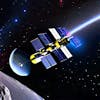S03E32: Red Planet Riddles & The Dawn of Coordinated Lunar Time

Prepare to traverse the Martian dunes and lunar craters with today's episode of Astronomy Daily - The Podcast. Host Anna guides us through a cosmic odyssey, starting with the baffling methane mysteries on Mars. Could this be a sign of life, or are we...
Prepare to traverse the Martian dunes and lunar craters with today's episode of Astronomy Daily - The Podcast. Host Anna guides us through a cosmic odyssey, starting with the baffling methane mysteries on Mars. Could this be a sign of life, or are we witnessing geological marvels? We delve into the necessity of a moon-specific time zone—Coordinated Lunar Time (CLT)—as we plan for future lunar habitats and the precision required for celestial coordination.
We also celebrate the triumphant return of Voyager 1's communication, a testament to human ingenuity across the stars. This episode further explores the challenges and triumphs of NASA's Perseverance rover as it captures the elusive atmospheric phenomena of the Red Planet. With its suite of sensors, Perseverance is piecing together the atmospheric puzzles of Mars, one sol at a time.
Join us for a cosmic conversation that not only seeks answers but also inspires awe at the mysteries that await us in the vastness of space. This is Astronomy Daily - The Podcast, where we bring the universe closer to home. Tune in, stargazers, for an episode that promises to ignite your imagination and expand your cosmic horizons.
---
**Featured Topics:**
1. **Mars' Methane Enigma:** Deciphering the sporadic presence of methane in the Martian atmosphere with NASA's Curiosity rover.
2. **Coordinated Lunar Time:** The intricacies and necessities of establishing a time zone on the moon for future exploration and settlement.
3. **Voyager 1's Interstellar Triumph:** Celebrating the spacecraft's recent recovery from a communication hiccup, showing the resilience of our distant explorer.
4. **Perseverance's Atmospheric Insights:** A close look at how NASA's rover is overcoming challenges to reveal Mars' dynamic weather patterns.
---
**Additional Information:**
For more cosmic content, visit astronomydaily.io, where you can explore our extensive episode archive, subscribe to our newsletter, and join the conversation with fellow space enthusiasts on X (@AstroDailypod). Don't forget to download and listen through your preferred podcast platforms, including Apple Podcasts, Spotify, and iHeartRadio. Share the wonders of the universe with others by passing along this episode and help our community of stargazers grow. Until next time, keep looking up and stay curious with Astronomy Daily - The Podcast.
**Host Sign-off:** Anna: As we wrap up today's celestial journey, I'm Anna, reminding you to keep your eyes on the skies and your hearts filled with wonder. Join us again as we continue to explore the awe-inspiring expanses of our universe. Clear skies and cosmic dreams to all.
(00:00) Welcome to Astronomy daily, the podcast that explores the cosmos
(01:30) NASA's Curiosity rover has detected trace amounts of methane on Mars
(04:02) NASA is working with FAA to create coordinated lunar time
(06:54) Voyager one successfully reconnects with Earth after mysterious period of silence
(12:25) This is the astronomy daily podcast signing off
This episode is brought to you with the help of NordPass, the password manager that will make your online life so much easier. To grab our special offer and find out more, visit www.bitesz.com/nordpass
Become a supporter of this podcast: https://www.spreaker.com/podcast/astronomy-daily-the-podcast--5648921/support.
AI Transcript
Welcome to Astronomy daily, the podcast that explores the cosmos
Anna: Welcome to Astronomy Daily, the podcast, your beacon for the celestial curious and the space enthused. Today's journey will traverse the enigmatic dunes of Mars and settle among the craters of the moon as we align our watches to lunar time. We're here to dive deep into the cosmic news cycle, unraveling the mysteries of the universe. One discovery at a time, with a cavalcade of stories were set to delve into curiosity, sparking anomalies like the puzzling presence of methane on the red planet, a, surprising find that has left scientists with more questions than answers. We'll consider the ramifications of establishing a time zone on the moon, a concept that feels straight out of Sci-Fi literature, yet is grounded in the necessity of future celestial coordination. The episode will also include an enthralling update on Voyager, one, humanity's most distant emissary, which continues to defy the odds and connect us with the vastness of interstellar space. Not to forget, we'll analyze how NASA's perseverance rover is conquering the atmospheric hurdles on Mars to provide us with unparalleled insights. So settle in as we navigate through the cosmos, discussing each of these stories in detail to satisfy your astronomical appetite. This is astronomy daily, the podcast the space where we bring the universe closer to home. Stay tuned. Execute the astronomy Daily podcast.
NASA's Curiosity rover has detected trace amounts of methane on Mars
Methane on the red Planet this elusive molecule has stirred an extraordinary scientific debate since the day NASA's Curiosity rover unearthed its sporadic presence in the martian atmosphere. These detections are startling because here on Earth, methane is predominantly produced by biological processes, raising the question, could there be life on Mars, or are we witnessing the workings of unknown geological processes? Curiosity's onboard lab, the sample analysis at Mars, or Sam, has sniffed out traces of this gas near gale crater's surface, making it an exclusive martian locale for such findings. Methane appears and vanishes with the change of seasons and even surges to dramatic concentrations, challenging our current understanding. Measurements have shown that, unlike Earth, this methane isn't lingering in the atmosphere, often prompting more questions than providing answers. European Space Agency's exomars trace gas orbiter embarked on a mission to unravel. This mystery has remarkably detected no methane. Further intensifying the enigma is Mars teasing us with a cosmic game of hide and seek with these methane emissions, leaving researchers to navigate a narrative filled with more plot twists than a mystery novel. Theories suggest that the gas might be trapped under a solidified salt in the martian soil, breaking free as temperatures fluctuate, possibly during the warmer seasons or times of day. Imagine a, Mars rover the size of an suv, accidentally cracking the surface seal, allowing captured methane to puff into the atmosphere, a phenomenon speculated to be at play only in areas that have felt the touch of these roving emissaries. The evidence doesn't come without its own set of challenges. The Curiosity rover is equipped for a multitude of scientific endeavors, of which only a fraction involves sniffing for methane. Each is a demanding task, conserving resources for selective sampling times. The persistence of Curiosity's endeavors leaves us contemplating a future where a new generation of surface instruments might offer continuous measurements across the martian, scapegoating relentlessly in pursuit of the fugitive methane's origins. It isn't the faint hearted who trek the cosmos for answers. And as the Curiosity mission scientists delve deeper into the mechanics behind Mars methane mystery, each discovery becomes a piece of a larger cosmic puzzle, inviting us to ponder the complexities of our own origins and the potential for life beyond Earth.
NASA is working with FAA to create coordinated lunar time
As humanity extends its reach to the moon and beyond, one might wonder about the practical considerations of living and working on other celestial surfaces. Imagine this. What time is it on the moon? It's not as straightforward as glancing at your wristwatch. This is where NASA steps in with an intriguing new undertaking to create what is to be known as coordinated lunar time, or CLT. Setting up camp on the lunar surface necessitates a, standardized approach to time. It's not just for the coordination between lunar explorers and operations on Earth, but also for precision navigation and scientific endeavors. A synchronized time zone is vital for managing the intricate dance of spacecraft, robots, and humans during lunar activities. Timing in space is crucial, much like how GPS satellites underpin the very fabric of terrestrial navigation. But why not just use the time zones we have on Earth, you might ask? Here's where things get interesting. Due to the phenomenon known as gravitational time dilation, time actually moves ever so slightly faster on the moon than it does here on our home planet. Over a 24 hours period, this discrepancy amounts to a, mere 58.7 microseconds. But even such minuscule differences can throw a wrench into the high precision operations of space exploration. Developing the coordinated lunar time requires a robust and traceable system that remains resilient even in the event of lost contact with Earth, an inevitable scenario in the vast, silent expanse of space. The plan is to have atomic clocks on the moon synced with coordinated universal time back on Earth, a, teamwork feat of the world's best timekeepers. The creation of CLT won't just streamline lunar operations. It will also set the stage for future endeavors where humanity might reach, be it Mars, asteroids, or the outer fringes of our solar system. There's a beautiful symmetry in the idea that, as we chart unknown territories, were also charting new realms of time itself. This ambitious project is on a tight deadline with NASA, given until the end of 2026 to establish the coordinated lunar time. As we count down the days making CLT a reality, we are not just watching the making of a moon time zone. We're witnessing the very ticking of the clock that will time stamp humanity's footprint in the cosmos. In a pioneering initiative to bolster our planet's defenses against the escalating threat of wildland fires, NASA has joined forces with the FAA. Together, they are channeling their expertise into developing cutting edge technologies. While details are forthcoming, this collaboration holds the promise of transforming our response to these natural disasters through space age innovation. Keep an ear out for updates on this significant endeavor as they emerge.
Voyager one successfully reconnects with Earth after mysterious period of silence
The saga of the Voyager one spacecraft is a chronicle of human ambition etched across the vast emptiness of space. Recently, it added another chapter, reminding us of the sheer audacity of its endeavor as it communicated back with Earth after a mysterious period of silence, a testament to the unwavering ingenuity of the teams here on the ground. Launched in 1977, this probe has long outlived its original mission, yet continues to push the boundaries of our solar system. Late in 2023, Voyager one perplexed scientists as it began sending what seemed to be nonsensical data, a string of garbled messages that betrayed no clear diagnosis. This unexpected development led to a palpable tension among mission engineers and scientists as they delved into decades old documents, searching for clues to rescue a spacecraft billions of kilometers away, nestled within the confines of the Jet Propulsion Laboratory, a team of dedicated engineers embarked on a painstaking journey of trial and error. The spacecraft, although resilient, was showing its age, and the issues at hand hinted at a possible falter in the flight data subsystem, a crucial component that orchestrates the flow of scientific information back to our home planet. Like explorers decoding an ancient script, the team sent a series of poke commands across the interstellar dividend, urging Voyager one to reveal the intricacies of its memory bank. The revelation was that a single chip had failed, compromising about 3% of the system's memory, an error margin small, yet critical enough to impede proper data packaging, and transmission. Faced with the impossibility of physical repair, the engineers crafted a masterstroke of problem solving from Earth across the indomitable void. By reallocating portions of the spacecraft's code to undamaged areas of memory, they beckoned Voyager one back into the realm of coherent communication. Their efforts bore fruit as clear data once again traversed the cosmic expanse to reach us on April 20, a, beacon of successful remote repair. Not unlike a virtual handshake across the cosmos, Voyager one's renewed connection does not only symbolize the culmination of problem solving under extreme constraints, it extends our presence into the interstellar medium. With the crafts science and engineering data trickling back, the scientific community breathes a collective sigh of relief. Attention can now turn back to gleaning insights from the farthest human made object from Earth, a singular emissary to the stars that holds within it both our infinite curiosity and the boundless potential of human ingenuity. The astronomy Daily podcast the martian atmosphere is a tapestry of fleeting mysteries. Ephemeral clouds drift by, leaving behind only shadows for clues, and elusive dust devils dance across the terrain, sometimes observed, often missed. These are the enigmas that NASA's Perseverance rover is determined to unravel with the Mars environmental dynamics analyzer, or meta. Perseverance, has its finger on the pulse of the red planet's atmospheric conditions, diligently recording data every hour of the martian day. Known as a sol, this relentless vigilance is crucial for capturing those unpredictable atmospheric phenomena that may hold the secrets to martian weather patterns and environmental processes. The pursuit of such knowledge is not without challenges. For instance, imaging a transient cloud formation is a race against time. Miss it by a soul, and it's gone forever. Observing a dust devil requires anticipation, a bit of luck, and precise timing, since the rover's daily itinerary, meticulously planned down to the minute, leaves little room for spontaneity. To outwit the fleeting nature of these phenomena, the Mars 2020 team employs specialized sensors that continuously gather meteorological data, while the rover's cameras and microphone collect snapshots and soundscapes over a series of souls. To build a statistical understanding of when and where these elusive events are most likely to occur, the team adapts to martian seasonality, intensifying observations when environmental circumstances hint at the emergence of unusual atmospheric activities. Near the close of Mars cloudy season, Perseverance was trying to capture something as evanescent as a halo, a phenomenon that reveals itself only when hexagonal ice crystals coalesce in an atmosphere rich with water vapor. After several attempts, success arrived just before the season's end, much like capturing a rare celestial snapshot that may not repeat itself for another martian year. Moreover, amid the bustle of stirring dust storms, the rover triumphs in providing valuable measurements of unprecedented dust opacities. These observations are pivotal, offering researchers an understanding of the impacts and dynamics of martian dust storms, contributing pieces to the larger puzzle of Mars atmospheric behavior. It is perseverance, true to the rover's name, that enables these remarkable feats. It is the same perseverance that refines our knowledge, igniting excitement with every cloud and dust devil captured, every storm analyzed. As we continue to listen and observe, the red planet shares its secrets one sol at a time. With NASA's Perseverance rover serving as our diligent and unwavering sentinel.
This is the astronomy daily podcast signing off
As we bring today's journey across the cosmos to a close, I'd like to extend an invitation to continue this celestial exploration together. For up to the minute updates on all things astronomical, swing by our website, astronomydaily IO. Here you'll find a constellation of resources to enrich your knowledge and spark your curiosity. Delve into our ever evolving newsfeed, stay ahead of the curve with the astronomy daily newsletter, and revisit the vast universe of information in our back episodes. You'll also discover all the links and details of our generous sponsors who make this podcast possible. If you're thirsty for more cosmic tales, we're just a search away on x, previously known as Twitter. Look for Astropod Daily and you'll find us orbiting in the social media sphere, ready to engage with fellow astronomy aficionados. For those who like their stargazing on the go astronomy Daily, the podcast beams right into your favorite podcast apps, including Apple Podcasts, Spotify, and iHeartRadio. Take us with you and transform every commute or quiet moment into a stellar experience. Lastly, if you've enjoyed our astronomical voyage today, please help us share the wonders of the universe. Pass along this episode to someone who dreams of the stars, or to anyone who simply appreciates the majesty of our galaxy. Your support helps our community grow and thrive. Thank you for tuning in for your boundless curiosity and for being a part of our star studded audience. Until next time, this is Anna saying, keep your eyes on the skies and your curiosity alight. This is astronomy daily, the podcast signing off. The astronomy Daily podcast. www.astronomydaily.io
New to Astronomy Daily - The Podcast?
Here are some great episodes to start with.














